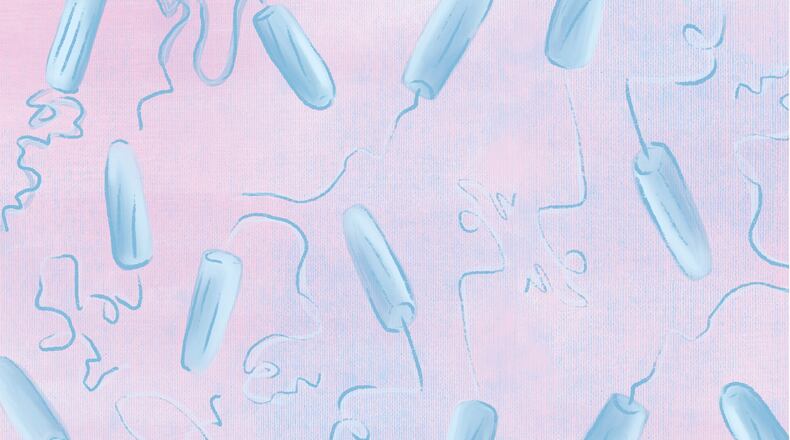More than a dozen metals — including lead and arsenic — were found in tampons, sparking concerns about menstruation products used by millions of women in the U.S., a new study found.
But what it means for women’s health is still unknown, due to a lack of data. As far as the paper’s authors could tell, no other paper had ever looked into the issue.
From 50% to 80% of girls and women who menstruate use tampons for nearly a week every month for decades of their lives.
Dr. Cherie Hill, an Emory Healthcare gynecologist and obstetrician said she was very surprised to learn these findings are only coming to light now.
“We’ve heard about heavy metals in other sources like water and clothing, and I was just like, ‘Why wouldn’t we have looked at tampons previously?’” she said.
The study, led by a UC Berkeley researcher and scheduled to be published next month in the journal Environment International, evaluated levels of 16 metals in tampons: arsenic, barium, calcium, cadmium, cobalt, chromium, copper, iron, manganese, mercury, nickel, lead, selenium, strontium, vanadium, and zinc. They looked at 30 tampons from 14 different brands sold in the U.S. and Europe. They included organic and non-organic tampons, name brands and generic store brands.
The brands tested were not named in the report, but researchers found metals were present in all types of tampons studied. Lead concentrations were higher in non-organic tampons but arsenic was higher in organic tampons.
Researchers said more investigation is needed to better understand the risk posed to women. More research is also needed to test how much, if any, of the metals leach out of the tampons and are absorbed by the body.
The findings are particularly concerning because the vagina has a higher potential for chemical absorption than skin elsewhere in the body, and can result in system-wide exposure. Chronic exposure to metals have been found to increase the risk of a wide variety of health woes including heart disease, dementia, infertility, diabetes, and cancer. In addition, metals can harm maternal health and fetal development.
Given the potential for a major health concern, it’s an area of surprisingly little research.
Credit: AP
Credit: AP
Lead author Jenni A. Shearston, a postdoctoral scholar at the UC Berkeley School of Public Health and UC Berkeley’s Department of Environmental Science, Policy, & Management said she thinks their research is the first to measure metals in tampons.
“Concerningly, we found concentrations of all metals we tested for, including toxic metals like arsenic and lead,” she said in a news release about the study.
Such metals are all around us because of modern manufacturing, according to Dr. Nathaniel DeNicola, an expert on environmental health at the American College of Obstetricians and Gynecologists, or ACOG, which issues guidance to U.S. OB/GYN’s, and chair of the committee on environmental health for the Federation of International Gynecology and Obstetrics. He said it’s important to follow up to see what if any levels of the metals wound up in the women’s bodies.
“There’s no guidance (that says) ‘stay away from tampons,’ DeNicola said. “And I don’t know that that would be my clinical advice to my patients either. But it would kind of be part of informed counseling and informed consent for women who are going to keep using them.”
Hill said she doesn’t think women should “throw out all of their tampons,” but there were some alarming findings in the study that could give some women pause about the continued use of tampons. She said more research is critically needed to know the impact.
Credit: AtlantaProfessionalHeadshots.com
Credit: AtlantaProfessionalHeadshots.com
“We need to know what is going into our bodies and we need to know how that will impact our health,” she said.
“The paper talks about lead present in all of (the tampons) and we don’t know if there’s a safe level of lead that should ever be in your body,” she said. “Some people may say ‘Because I don’t know the impact, I want to avoid it.’”
But even alternatives, including silicone based menstrual cups and period underwear have questions about their safety and more research is needed on those products too, she said. Many brands of menstrual pads contain elevated levels of chemicals linked to developmental and reproductive harm, according to a 2019 study in the journal Reproductive Toxicology.
Researchers noted metals could make their way into tampons a number of ways: The cotton material could have absorbed the metals from water, air, soil, through a nearby contaminant (for example, if a cotton field was near a lead smelter), or some might be added intentionally during manufacturing as part of a pigment, whitener, antibacterial agent, or some other production process.
The Food and Drug Administration, which regulates tampons in the U.S., doesn’t necessarily study them before they go on the market, said DeNicola, the environmental health expert.
”To me it (the study) more highlights the need for some degree of, if not regulation, at least independent third-party testing for all these thousands upon thousands of chemicals that are part of the US manufacturing process on a on a yearly basis.”
The FDA, which regulates menstrual products, told The Atlanta Journal-Constitution that it is reviewing the findings, but noted that all studies have limitations.
“While the chemical method used indicates these metals are present in the tampons tested in the laboratory, the study does not assess whether any metals are released from tampons when used in the body. It also does not address whether any metal, if released, can be absorbed into the vaginal lining or, subsequently into the bloodstream,” a spokesperson for the agency said.
Concerns about tampons go back decades. In 1980 scientists confirmed concerns that super-absorbent tampons were associated with toxic shock syndrome.
The lack of data available on tampons and metals’ health impacts is part of larger gaps in scientific research on women and chronic conditions, gaps that the National Academies of Sciences, Engineering, and Medicine found in a new report on the topic Wednesday. “Significant gaps in what is known about chronic conditions that are specific to women, predominantly impact women, or affect them differently ... hinder diagnosis, treatment, and prevention,” the report found. It calls on the National Institutes of Health and other relevant federal research agencies to enhance their research efforts to better understand chronic conditions in women.
But pressure is mounting for more disclosure, research and transparency.
In 2021, New York became the first state to enact a menstrual product disclosure law require companies to list all intentionally added ingredients on packaging.
At least five other states have introduced legislation to address safety and require disclosure of ingredients in these items, according to Women’s Voices for the Earth. Georgia is not one of them.
Researchers of the study also acknowledged while it’s unclear if the metals detected in the study are contributing to any negative health effects, they say their research emphasizes the need for more testing of products for metals, especially toxic metals.
“I really hope that manufacturers are required to test their products for metals, especially for toxic metals,” Berkeley’s Shearston said in a news release. “It would be exciting to see the public call for this, or to ask for better labeling on tampons and other menstrual products.”
Keep Reading
The Latest
Featured





